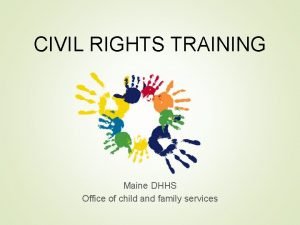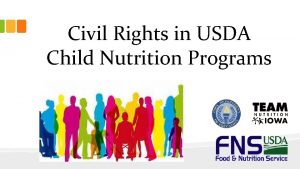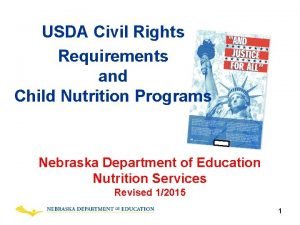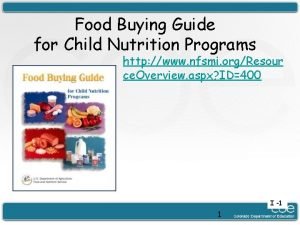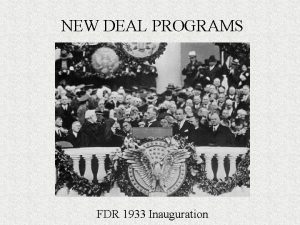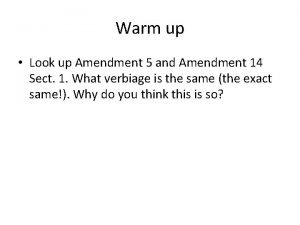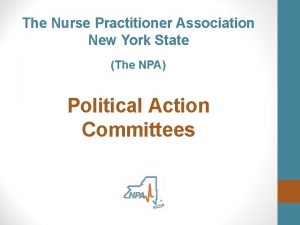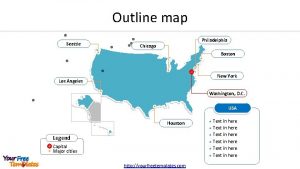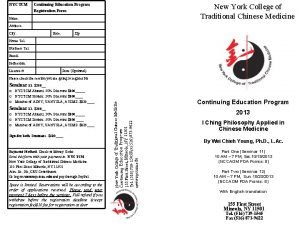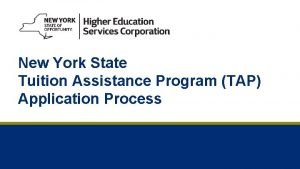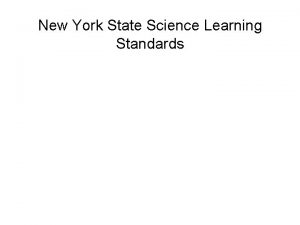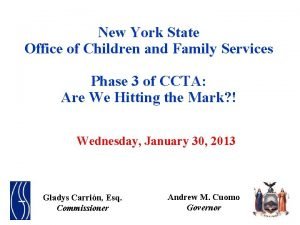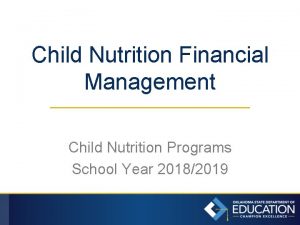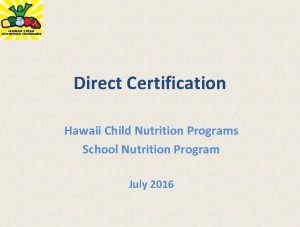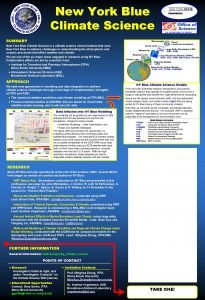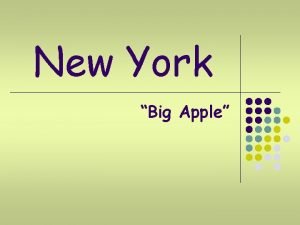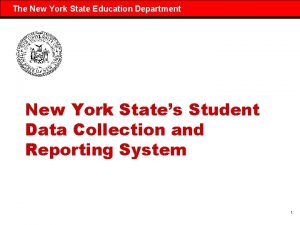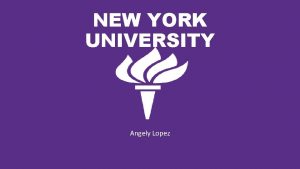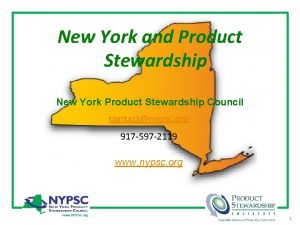Financial Management of School Nutrition Programs New York







































- Slides: 39

Financial Management of School Nutrition Programs New York State Education Department Child Nutrition Program Administration

Facts National School Lunch Program q 30 million lunches per day nationally q NYS-1. 65 million students served per day q 14 million breakfast served per day nationally q 700, 000 students served per day nationally School Breakfast Program q 3 million Summer Food meals served daily in the summer Summer Food Service Program q 350, 000 students served per day

School Nutrition Programs } Serve millions of children daily } Managing the financial resources of these programs is critical } Ability to interpret the financial outcomes of operational decisions } Benchmark best practices

Financial Management Competencies Ø Develop financial management guidelines that supports school nutrition program operational goals and comply with regulations Ø Establish cost control goals to effectively manage the school nutrition program

Activities for Effective Financial Management • Develop an annual budget & adjust as needed • Maintain a written internal control policy • Apply efficient cost control measures • Increase productivity • Identify ways to increase resources

Financial Management System Ø Uniform and consistent financial reporting structure Ø Meaningful and timely financial management information Ø Understanding federal, state, and local reporting requirements Ø NSLP – 7 CFR 210. 14 Ø UGG 2 CFR 200

Accountability: Reporting Requirements for SFAs Public school districts complete the ST-3 schedules for Fund C on SAMS (State Aid Management System) Non-publics and charter schools complete a statement of cash analysis and submit it with a copy of their balance sheet and profit & loss statement

Accountability: The Administrative Review

Paid Lunch Equity Tool SFAs must comply with the requirements for pricing paid lunches (7 CFR 210. 14(e)) Paid Lunch Equity Tool must be completed annually

Revenue: Paid Lunch Equity (PLE) Analysis Step One: Calculate the SFA’s average price for all types of paid student lunches Step Two: Compare SFA’s average paid lunch price with the USDA weighted average (2017 -18 = $2. 86) and SFA’s required weighted average price based on adjusting price requirement to the 2016 -17 paid amount Step Determine if a price increase is Three: necessary

Revenue Increase Options for Student Meals Ø Increase meal prices Ø Add approved non-Federal revenue Ø Use a combination of increased paid meal prices and non-Federal revenue

Evaluating Revenue Ø Determine if and where revenue should be increased Ø Analyze revenue by source Ø Identify areas in which revenue should be monitored for revenue loss

Revenue Analysis Calculate Compare Establish Calculate average revenue per meal or meal equivalent Compare revenue generated per meal with costs per meal Establish consistent guidelines for pricing nonprogram food items to ensure revenue is equal to or greater than costs

Revenue: Non-Program Foods Ø Adult meals Ø Sale of second meals Ø A la carte Ø Individual food items Ø Catering

Revenue: Adult Price Formula Free Student Lunch Federal Reimbursement + Per meal value of USDA Foods+ 6 Cents Performance Based Reimbursement = Minimum Adult Price

PLE Exemption • 1/31/18 positive and zero account balances • Email cn@nysed. gov request and P&L Statement • SED will process requests and email determinations • Approved SFAs maintain documentation and approval

Non-Program Foods Sales Ø Catered food or meals Ø Contract meals Ø Special school function meals such as banquets

Non-Program Revenue Total Non-program Foods Revenue Total Program Revenue ≥ Total Non-program Food Costs Total Food Costs

Measuring Compliance with the USDA Nonprogram Revenue Tool

Revenue: A la Carte Pricing (Nonprogram) Evaluate Pricing pricing matters

Evaluating Expenditures Ø Patterns or trends Ø Significant changes in cost categories Ø Deviations from financial goals Ø Possible abuse or theft Ø Transaction errors

Classification of Expenditures • Labor • Supplies • Employee Benefits • Capital Assets • Professional and Technical Services • Miscellaneous • Indirect Costs • Fund Transfer-Out • Property Services • Purchased Foods and USDA Foods

Criteria for Allowable Costs Ø Necessary Ø Reasonable Ø Allocable Ø Applied uniformly to both federal and non-federal activities of the entity Ø Consistently treated as direct or indirect Ø Determined in accordance with Generally Accepted Accounting Principles (GAAP) Ø Not included as a cost or matching contribution to any other grant Ø Adequately documented

Operating ratios Types of Expenditure Analysis • Cost of food/total revenue = % Costs to produce a meal compared with the average revenue generated per meal Total cost to produce one meal Meals per labor hour • Number of meal equivalents served in a day/number of paid hours

Expenditure: Controlling Labor is an essential cost to food service Meals Per Labor Hour tool evaluates labor and productivity Meal Equivalents

Meal Equivalent Conversions Meal Equivalent Formula 1 lunch = 1 meal equivalent 3 breakfasts = 2 meal equivalents (2/3 =. 67) Avg. Daily Non-program food sales (excludes adult meals) 3 snacks = 1 meal equivalent (1/3 =. 33) (Revenue from non-program sales ÷ current free lunch reimbursement) current USDA Foods value per lunch

Meals Per Labor Hour Formula Number of Meal Equivalents = Meals Per Labor Hour (MLPH) Labor Hours

Meals Per Labor Hour Example A food service director wanted to calculate the meals per labor hour from the previous day. The lunch program reported the following meals served and labor hours paid: 425 lunches, 150 breakfasts, 175 snacks 32 labor hours Calculation Lunch 425. 00 Meal Equivalents Breakfast (150 x. 67) 100. 50 Meal Equivalents Snack (175 x. 33) 57. 75 Meal Equivalents Total 583. 25 Meal Equivalents 583. 25 meal equivalents ÷ 32 labor hours = 18. 227 or 18 Meals Per Labor Hour

Meals Per Labor Hour

size of operation Factors Affecting Meals Per Labor Hour complexity of the menu, etc. number of serving lines skill level of employees type service provided amount of convenience foods used scheduling of lunch periods production system

Share of general schools’ costs that are incurred for common or joint purposes Expenditure: Indirect Cost Indirect costs include: human resources payroll accounting, budgeting, purchasing, utilities (light, heat, etc. ), etc. See USDA memo SP 60 -2016, dated September 30, 2016

Share of general schools’ costs that are incurred for common or joint purposes Indirect Cost Indirect costs include: Human Resources, Payroll, Accounting, Budgeting, Purchasing, Utilities

Participation is key to creating a financially healthy and successful Child Nutrition Program SFAs are encouraged to be innovative and creative in delivery of their child nutrition programs Taste testing Marketing

Calculate the Cost of Food 01 02 03 04 Determine if costs are within guidelines, Ascertain if there are sufficient funds to pay expenditures, Establish the cost of each meal equivalent served, and Prevent waste and food theft through monitoring food usage.

Calculating Cost of Food Used Beginning Food Inventory + Total Food Purchases - Ending Food Inventory = Total Food Available = Cost of Food used

Example of Calculations for Cost of Food Used Example Beginning Inventory Annually $ 8, 000 Food Purchases + 300, 000 Food Available $ 308, 000 Less: ending inventory Cost of Food Used - 7, 000 $ 301, 000 Monthly $ 8, 000 25, 000 $ $ 33, 000 7, 000 26, 000

Inventory Management Best Practices Monitor inventory Use an inventory check list Have an effective food safety plan Buy American

Child Nutrition Knowledge Center – www. cn. nysed. gov • Tutorial Paid Lunch Equity Helpful Resources and Training: Managing your Child Nutrition Program Training • 4 day training in July • Training Topics: Financial Management, Menu Planning, Procurement School Food & Nutrition Service Management Book USDA Food and Nutrition Service https: //www. fns. usda. gov/sc hool-meals/child-nutritionprograms The Institute of Child Nutrition – www. theicn. org

Child Nutrition Program Administration 518 -473 -8781 cntraining@nysed. gov
 New york pennsylvania new jersey delaware
New york pennsylvania new jersey delaware Marquee cinemas new hartford
Marquee cinemas new hartford Strengths of the articles of confederation
Strengths of the articles of confederation Neil thisse is a loyalist who fled the colonies
Neil thisse is a loyalist who fled the colonies 102 graphic
102 graphic New york school poets
New york school poets Disadvantages of waterfall model in software engineering
Disadvantages of waterfall model in software engineering Civil rights training child nutrition programs
Civil rights training child nutrition programs Civil rights in child nutrition programs
Civil rights in child nutrition programs Civil rights in child nutrition programs
Civil rights in child nutrition programs Food buying guide
Food buying guide Third party risk management conference 2019 new york
Third party risk management conference 2019 new york New deal
New deal New york business etiquette
New york business etiquette Equal protection clause
Equal protection clause Merriweather library buffalo new york
Merriweather library buffalo new york New york state nurse practitioner association
New york state nurse practitioner association West egg long island
West egg long island Superman's other identity
Superman's other identity Taoki new york
Taoki new york Map boston to philadelphia
Map boston to philadelphia New york kurosu
New york kurosu Nyctcm
Nyctcm New york times upfront
New york times upfront Tap application ny
Tap application ny New york state teacher certification exams
New york state teacher certification exams New york state learning standards science
New york state learning standards science Ccta new york
Ccta new york Nys test 2018
Nys test 2018 Lega amerike
Lega amerike New york harm reduction educators
New york harm reduction educators Distretti new york
Distretti new york Map of harlem nyc
Map of harlem nyc Midwives new york
Midwives new york Dmi new york
Dmi new york Hunger in new york city poem
Hunger in new york city poem New york scale heart failure
New york scale heart failure West egg vs east egg
West egg vs east egg New york oceanic
New york oceanic Ellis island inspections
Ellis island inspections







